Destination Marketing Report: Challenges, Strategies, and Examples
VerifiedAdded on 2022/12/23
|15
|4938
|156
Report
AI Summary
This report provides a detailed analysis of destination marketing, focusing on the principles, campaigns, and digital tools used to promote destinations. The report begins by explaining the fundamental marketing principles (Product, Place, Price, Promotion, People, Physical Evidence, Process) and how they support destination marketing, using examples like the Tower of London. It then delves into the key elements of destination marketing campaigns, using the GREAT Britain campaign as a case study to illustrate how campaigns are planned and executed to achieve objectives, including assessing Britain's competitive position. Furthermore, the report explores various digital marketing tools that can be utilized for destination promotion, and elaborates on the roles and functions of Destination Marketing Organizations (DMOs). Finally, it discusses the challenges faced by DMOs in marketing destinations, providing real-world examples. The report concludes by emphasizing the importance of effective destination marketing in driving tourism and socio-economic progress.
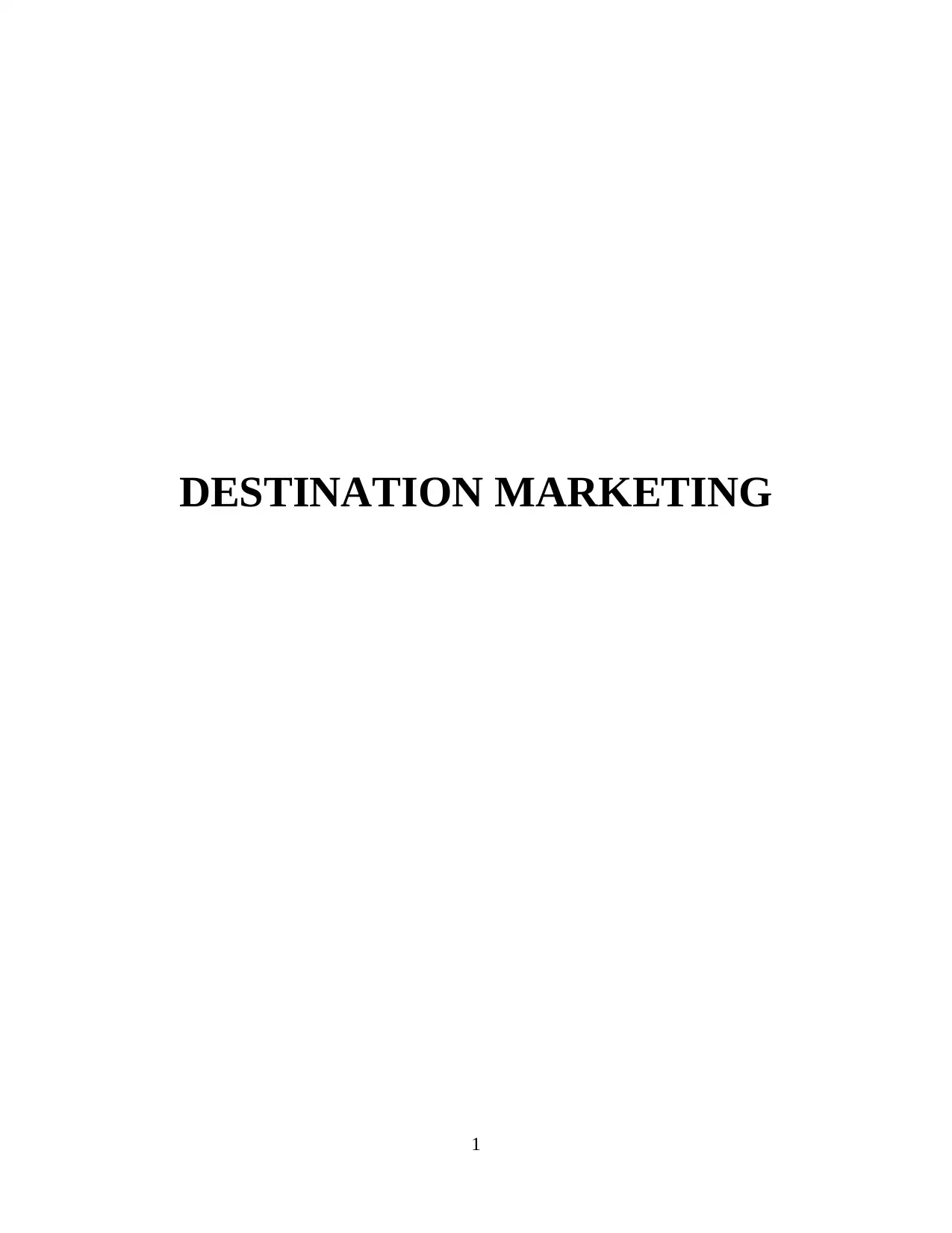
DESTINATION MARKETING
1
1
Paraphrase This Document
Need a fresh take? Get an instant paraphrase of this document with our AI Paraphraser
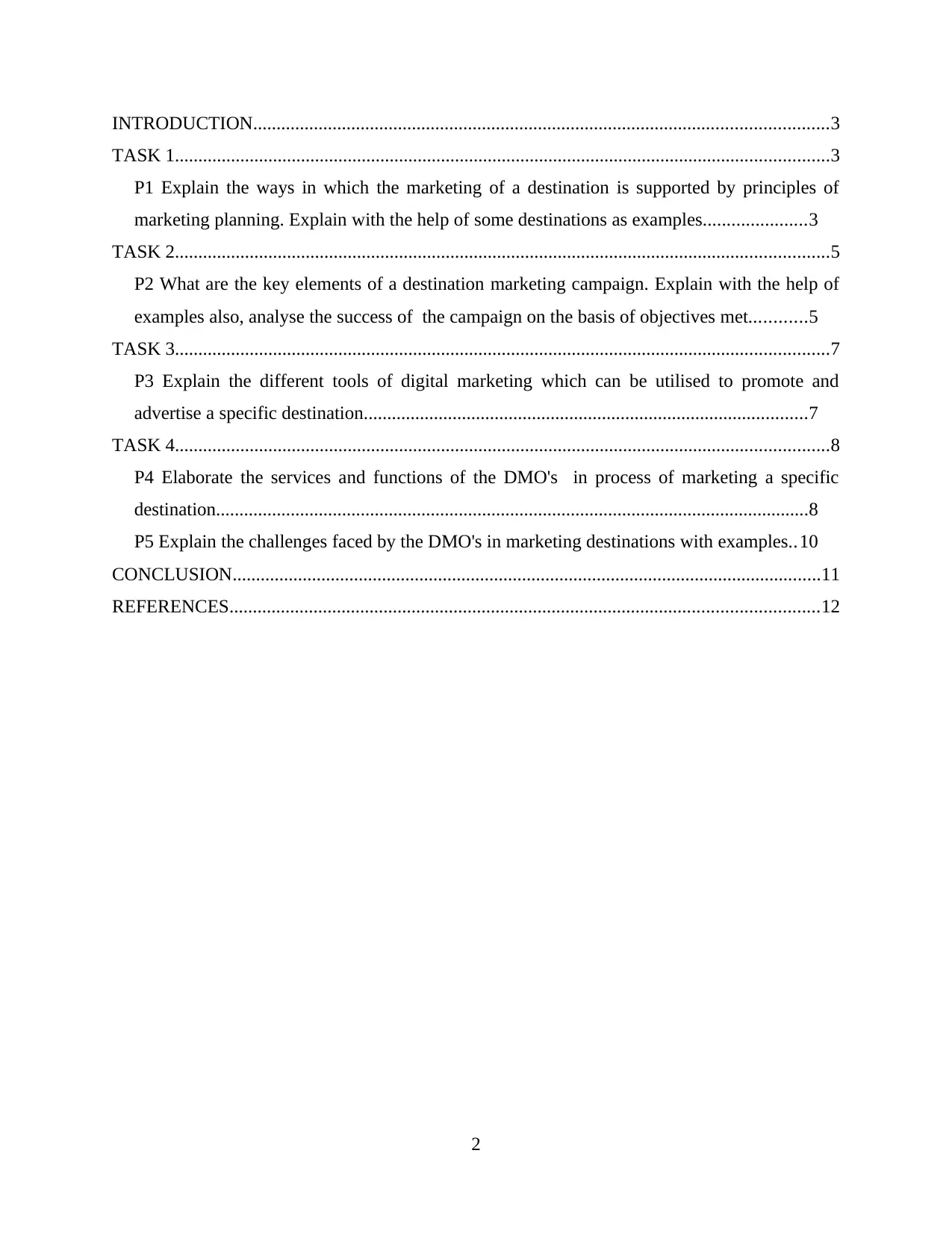
INTRODUCTION...........................................................................................................................3
TASK 1............................................................................................................................................3
P1 Explain the ways in which the marketing of a destination is supported by principles of
marketing planning. Explain with the help of some destinations as examples......................3
TASK 2............................................................................................................................................5
P2 What are the key elements of a destination marketing campaign. Explain with the help of
examples also, analyse the success of the campaign on the basis of objectives met............5
TASK 3............................................................................................................................................7
P3 Explain the different tools of digital marketing which can be utilised to promote and
advertise a specific destination...............................................................................................7
TASK 4............................................................................................................................................8
P4 Elaborate the services and functions of the DMO's in process of marketing a specific
destination...............................................................................................................................8
P5 Explain the challenges faced by the DMO's in marketing destinations with examples..10
CONCLUSION..............................................................................................................................11
REFERENCES..............................................................................................................................12
2
TASK 1............................................................................................................................................3
P1 Explain the ways in which the marketing of a destination is supported by principles of
marketing planning. Explain with the help of some destinations as examples......................3
TASK 2............................................................................................................................................5
P2 What are the key elements of a destination marketing campaign. Explain with the help of
examples also, analyse the success of the campaign on the basis of objectives met............5
TASK 3............................................................................................................................................7
P3 Explain the different tools of digital marketing which can be utilised to promote and
advertise a specific destination...............................................................................................7
TASK 4............................................................................................................................................8
P4 Elaborate the services and functions of the DMO's in process of marketing a specific
destination...............................................................................................................................8
P5 Explain the challenges faced by the DMO's in marketing destinations with examples..10
CONCLUSION..............................................................................................................................11
REFERENCES..............................................................................................................................12
2
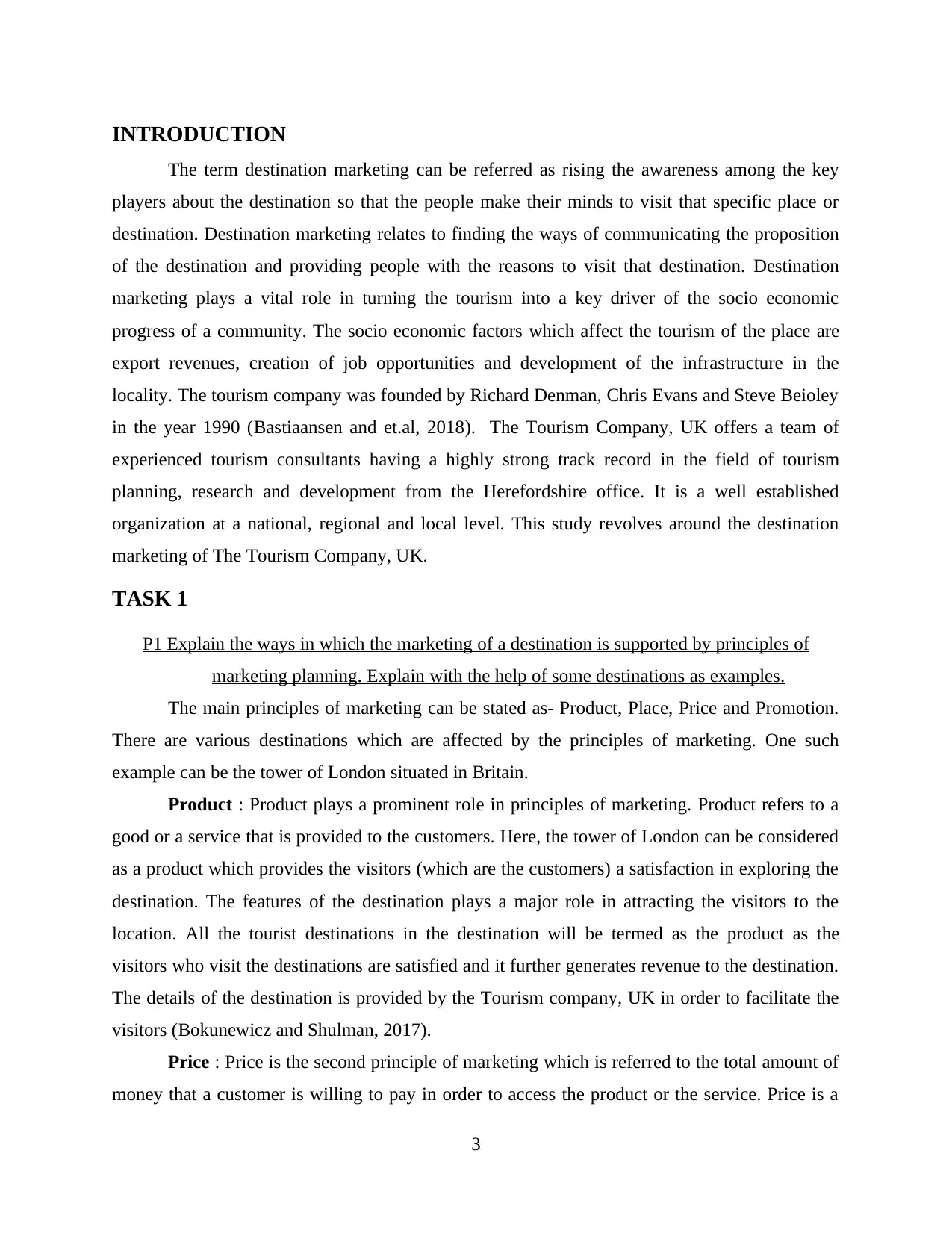
INTRODUCTION
The term destination marketing can be referred as rising the awareness among the key
players about the destination so that the people make their minds to visit that specific place or
destination. Destination marketing relates to finding the ways of communicating the proposition
of the destination and providing people with the reasons to visit that destination. Destination
marketing plays a vital role in turning the tourism into a key driver of the socio economic
progress of a community. The socio economic factors which affect the tourism of the place are
export revenues, creation of job opportunities and development of the infrastructure in the
locality. The tourism company was founded by Richard Denman, Chris Evans and Steve Beioley
in the year 1990 (Bastiaansen and et.al, 2018). The Tourism Company, UK offers a team of
experienced tourism consultants having a highly strong track record in the field of tourism
planning, research and development from the Herefordshire office. It is a well established
organization at a national, regional and local level. This study revolves around the destination
marketing of The Tourism Company, UK.
TASK 1
P1 Explain the ways in which the marketing of a destination is supported by principles of
marketing planning. Explain with the help of some destinations as examples.
The main principles of marketing can be stated as- Product, Place, Price and Promotion.
There are various destinations which are affected by the principles of marketing. One such
example can be the tower of London situated in Britain.
Product : Product plays a prominent role in principles of marketing. Product refers to a
good or a service that is provided to the customers. Here, the tower of London can be considered
as a product which provides the visitors (which are the customers) a satisfaction in exploring the
destination. The features of the destination plays a major role in attracting the visitors to the
location. All the tourist destinations in the destination will be termed as the product as the
visitors who visit the destinations are satisfied and it further generates revenue to the destination.
The details of the destination is provided by the Tourism company, UK in order to facilitate the
visitors (Bokunewicz and Shulman, 2017).
Price : Price is the second principle of marketing which is referred to the total amount of
money that a customer is willing to pay in order to access the product or the service. Price is a
3
The term destination marketing can be referred as rising the awareness among the key
players about the destination so that the people make their minds to visit that specific place or
destination. Destination marketing relates to finding the ways of communicating the proposition
of the destination and providing people with the reasons to visit that destination. Destination
marketing plays a vital role in turning the tourism into a key driver of the socio economic
progress of a community. The socio economic factors which affect the tourism of the place are
export revenues, creation of job opportunities and development of the infrastructure in the
locality. The tourism company was founded by Richard Denman, Chris Evans and Steve Beioley
in the year 1990 (Bastiaansen and et.al, 2018). The Tourism Company, UK offers a team of
experienced tourism consultants having a highly strong track record in the field of tourism
planning, research and development from the Herefordshire office. It is a well established
organization at a national, regional and local level. This study revolves around the destination
marketing of The Tourism Company, UK.
TASK 1
P1 Explain the ways in which the marketing of a destination is supported by principles of
marketing planning. Explain with the help of some destinations as examples.
The main principles of marketing can be stated as- Product, Place, Price and Promotion.
There are various destinations which are affected by the principles of marketing. One such
example can be the tower of London situated in Britain.
Product : Product plays a prominent role in principles of marketing. Product refers to a
good or a service that is provided to the customers. Here, the tower of London can be considered
as a product which provides the visitors (which are the customers) a satisfaction in exploring the
destination. The features of the destination plays a major role in attracting the visitors to the
location. All the tourist destinations in the destination will be termed as the product as the
visitors who visit the destinations are satisfied and it further generates revenue to the destination.
The details of the destination is provided by the Tourism company, UK in order to facilitate the
visitors (Bokunewicz and Shulman, 2017).
Price : Price is the second principle of marketing which is referred to the total amount of
money that a customer is willing to pay in order to access the product or the service. Price is a
3
⊘ This is a preview!⊘
Do you want full access?
Subscribe today to unlock all pages.

Trusted by 1+ million students worldwide
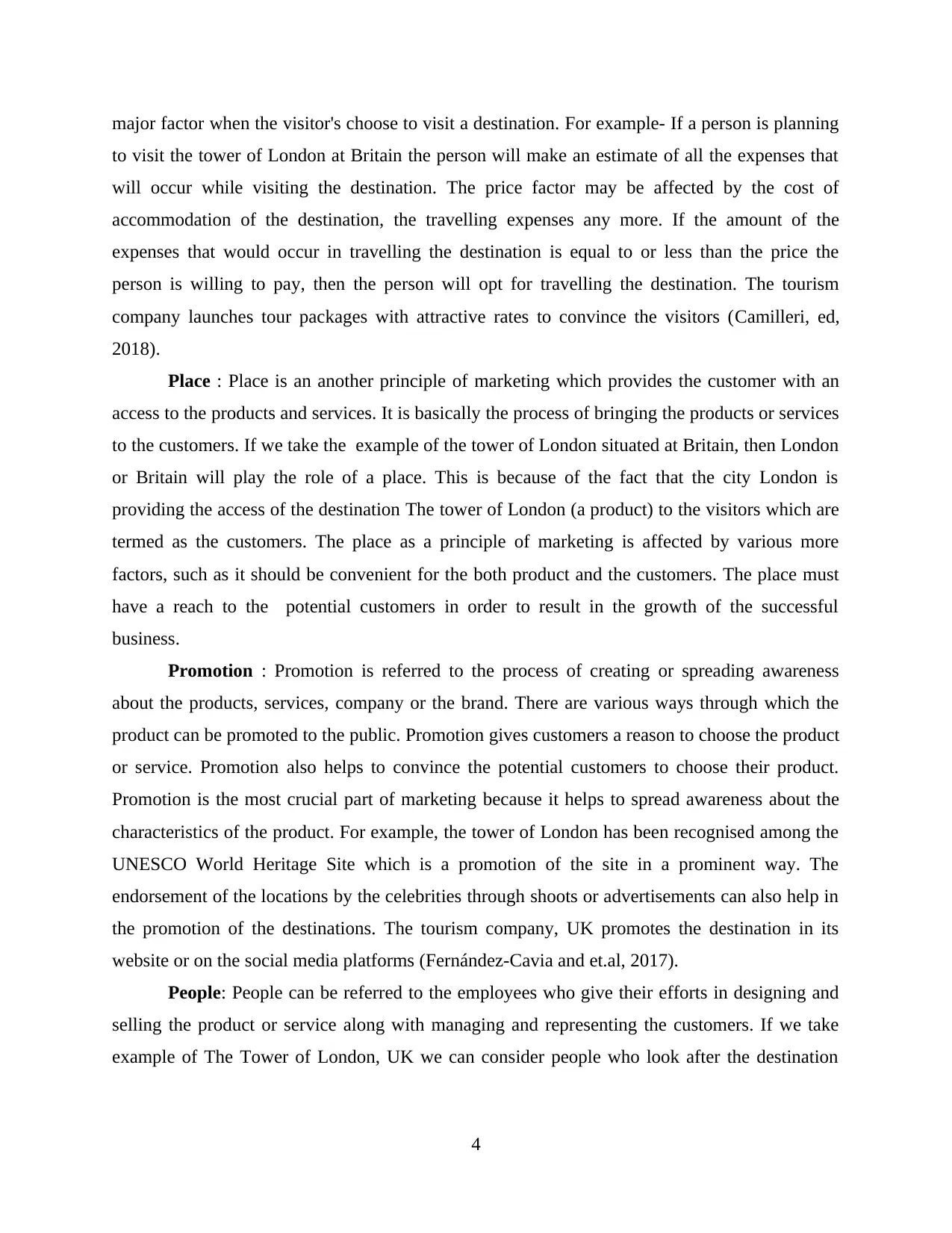
major factor when the visitor's choose to visit a destination. For example- If a person is planning
to visit the tower of London at Britain the person will make an estimate of all the expenses that
will occur while visiting the destination. The price factor may be affected by the cost of
accommodation of the destination, the travelling expenses any more. If the amount of the
expenses that would occur in travelling the destination is equal to or less than the price the
person is willing to pay, then the person will opt for travelling the destination. The tourism
company launches tour packages with attractive rates to convince the visitors (Camilleri, ed,
2018).
Place : Place is an another principle of marketing which provides the customer with an
access to the products and services. It is basically the process of bringing the products or services
to the customers. If we take the example of the tower of London situated at Britain, then London
or Britain will play the role of a place. This is because of the fact that the city London is
providing the access of the destination The tower of London (a product) to the visitors which are
termed as the customers. The place as a principle of marketing is affected by various more
factors, such as it should be convenient for the both product and the customers. The place must
have a reach to the potential customers in order to result in the growth of the successful
business.
Promotion : Promotion is referred to the process of creating or spreading awareness
about the products, services, company or the brand. There are various ways through which the
product can be promoted to the public. Promotion gives customers a reason to choose the product
or service. Promotion also helps to convince the potential customers to choose their product.
Promotion is the most crucial part of marketing because it helps to spread awareness about the
characteristics of the product. For example, the tower of London has been recognised among the
UNESCO World Heritage Site which is a promotion of the site in a prominent way. The
endorsement of the locations by the celebrities through shoots or advertisements can also help in
the promotion of the destinations. The tourism company, UK promotes the destination in its
website or on the social media platforms (Fernández-Cavia and et.al, 2017).
People: People can be referred to the employees who give their efforts in designing and
selling the product or service along with managing and representing the customers. If we take
example of The Tower of London, UK we can consider people who look after the destination
4
to visit the tower of London at Britain the person will make an estimate of all the expenses that
will occur while visiting the destination. The price factor may be affected by the cost of
accommodation of the destination, the travelling expenses any more. If the amount of the
expenses that would occur in travelling the destination is equal to or less than the price the
person is willing to pay, then the person will opt for travelling the destination. The tourism
company launches tour packages with attractive rates to convince the visitors (Camilleri, ed,
2018).
Place : Place is an another principle of marketing which provides the customer with an
access to the products and services. It is basically the process of bringing the products or services
to the customers. If we take the example of the tower of London situated at Britain, then London
or Britain will play the role of a place. This is because of the fact that the city London is
providing the access of the destination The tower of London (a product) to the visitors which are
termed as the customers. The place as a principle of marketing is affected by various more
factors, such as it should be convenient for the both product and the customers. The place must
have a reach to the potential customers in order to result in the growth of the successful
business.
Promotion : Promotion is referred to the process of creating or spreading awareness
about the products, services, company or the brand. There are various ways through which the
product can be promoted to the public. Promotion gives customers a reason to choose the product
or service. Promotion also helps to convince the potential customers to choose their product.
Promotion is the most crucial part of marketing because it helps to spread awareness about the
characteristics of the product. For example, the tower of London has been recognised among the
UNESCO World Heritage Site which is a promotion of the site in a prominent way. The
endorsement of the locations by the celebrities through shoots or advertisements can also help in
the promotion of the destinations. The tourism company, UK promotes the destination in its
website or on the social media platforms (Fernández-Cavia and et.al, 2017).
People: People can be referred to the employees who give their efforts in designing and
selling the product or service along with managing and representing the customers. If we take
example of The Tower of London, UK we can consider people who look after the destination
4
Paraphrase This Document
Need a fresh take? Get an instant paraphrase of this document with our AI Paraphraser
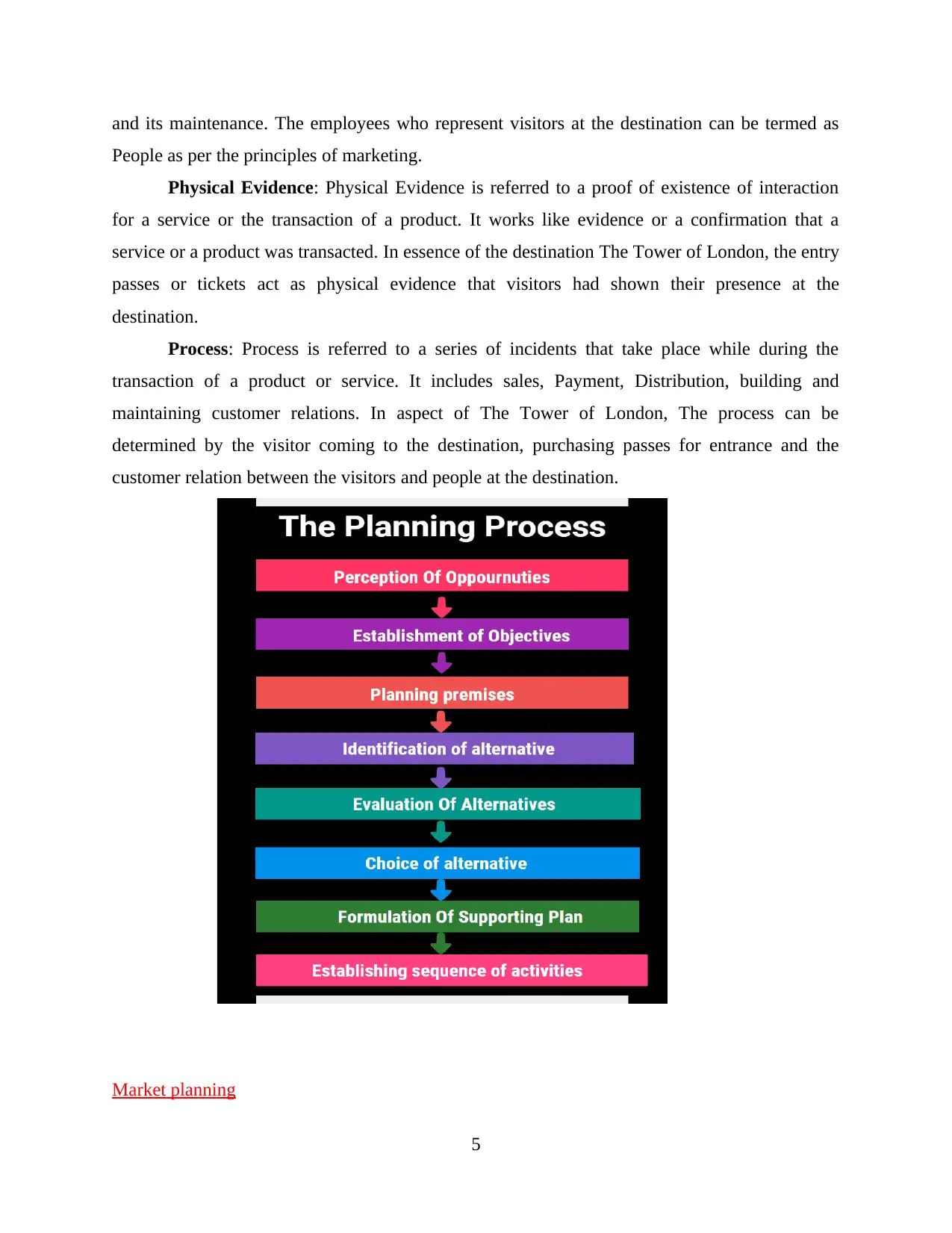
and its maintenance. The employees who represent visitors at the destination can be termed as
People as per the principles of marketing.
Physical Evidence: Physical Evidence is referred to a proof of existence of interaction
for a service or the transaction of a product. It works like evidence or a confirmation that a
service or a product was transacted. In essence of the destination The Tower of London, the entry
passes or tickets act as physical evidence that visitors had shown their presence at the
destination.
Process: Process is referred to a series of incidents that take place while during the
transaction of a product or service. It includes sales, Payment, Distribution, building and
maintaining customer relations. In aspect of The Tower of London, The process can be
determined by the visitor coming to the destination, purchasing passes for entrance and the
customer relation between the visitors and people at the destination.
Market planning
5
People as per the principles of marketing.
Physical Evidence: Physical Evidence is referred to a proof of existence of interaction
for a service or the transaction of a product. It works like evidence or a confirmation that a
service or a product was transacted. In essence of the destination The Tower of London, the entry
passes or tickets act as physical evidence that visitors had shown their presence at the
destination.
Process: Process is referred to a series of incidents that take place while during the
transaction of a product or service. It includes sales, Payment, Distribution, building and
maintaining customer relations. In aspect of The Tower of London, The process can be
determined by the visitor coming to the destination, purchasing passes for entrance and the
customer relation between the visitors and people at the destination.
Market planning
5
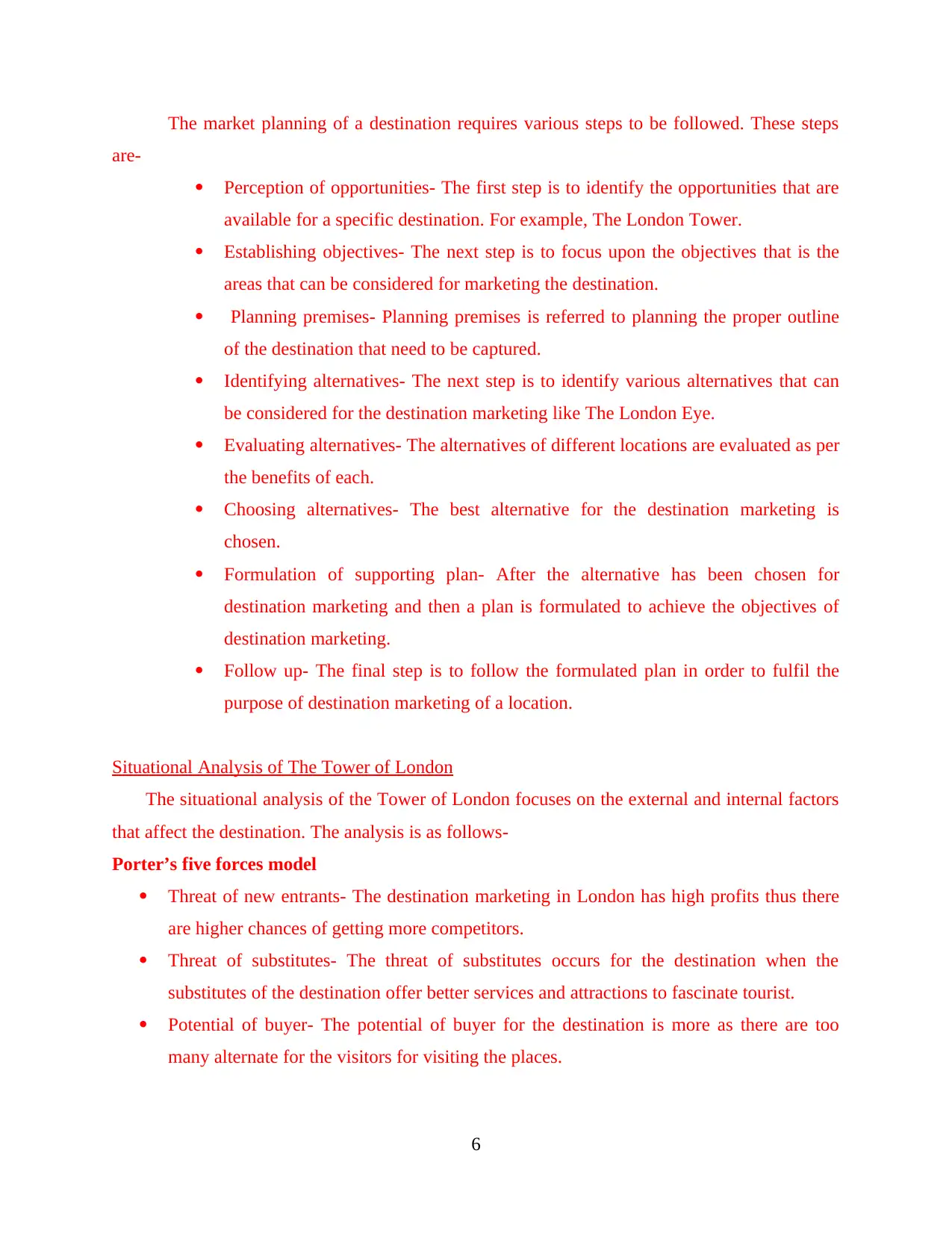
The market planning of a destination requires various steps to be followed. These steps
are-
Perception of opportunities- The first step is to identify the opportunities that are
available for a specific destination. For example, The London Tower.
Establishing objectives- The next step is to focus upon the objectives that is the
areas that can be considered for marketing the destination.
Planning premises- Planning premises is referred to planning the proper outline
of the destination that need to be captured.
Identifying alternatives- The next step is to identify various alternatives that can
be considered for the destination marketing like The London Eye.
Evaluating alternatives- The alternatives of different locations are evaluated as per
the benefits of each.
Choosing alternatives- The best alternative for the destination marketing is
chosen.
Formulation of supporting plan- After the alternative has been chosen for
destination marketing and then a plan is formulated to achieve the objectives of
destination marketing.
Follow up- The final step is to follow the formulated plan in order to fulfil the
purpose of destination marketing of a location.
Situational Analysis of The Tower of London
The situational analysis of the Tower of London focuses on the external and internal factors
that affect the destination. The analysis is as follows-
Porter’s five forces model
Threat of new entrants- The destination marketing in London has high profits thus there
are higher chances of getting more competitors.
Threat of substitutes- The threat of substitutes occurs for the destination when the
substitutes of the destination offer better services and attractions to fascinate tourist.
Potential of buyer- The potential of buyer for the destination is more as there are too
many alternate for the visitors for visiting the places.
6
are-
Perception of opportunities- The first step is to identify the opportunities that are
available for a specific destination. For example, The London Tower.
Establishing objectives- The next step is to focus upon the objectives that is the
areas that can be considered for marketing the destination.
Planning premises- Planning premises is referred to planning the proper outline
of the destination that need to be captured.
Identifying alternatives- The next step is to identify various alternatives that can
be considered for the destination marketing like The London Eye.
Evaluating alternatives- The alternatives of different locations are evaluated as per
the benefits of each.
Choosing alternatives- The best alternative for the destination marketing is
chosen.
Formulation of supporting plan- After the alternative has been chosen for
destination marketing and then a plan is formulated to achieve the objectives of
destination marketing.
Follow up- The final step is to follow the formulated plan in order to fulfil the
purpose of destination marketing of a location.
Situational Analysis of The Tower of London
The situational analysis of the Tower of London focuses on the external and internal factors
that affect the destination. The analysis is as follows-
Porter’s five forces model
Threat of new entrants- The destination marketing in London has high profits thus there
are higher chances of getting more competitors.
Threat of substitutes- The threat of substitutes occurs for the destination when the
substitutes of the destination offer better services and attractions to fascinate tourist.
Potential of buyer- The potential of buyer for the destination is more as there are too
many alternate for the visitors for visiting the places.
6
⊘ This is a preview!⊘
Do you want full access?
Subscribe today to unlock all pages.

Trusted by 1+ million students worldwide
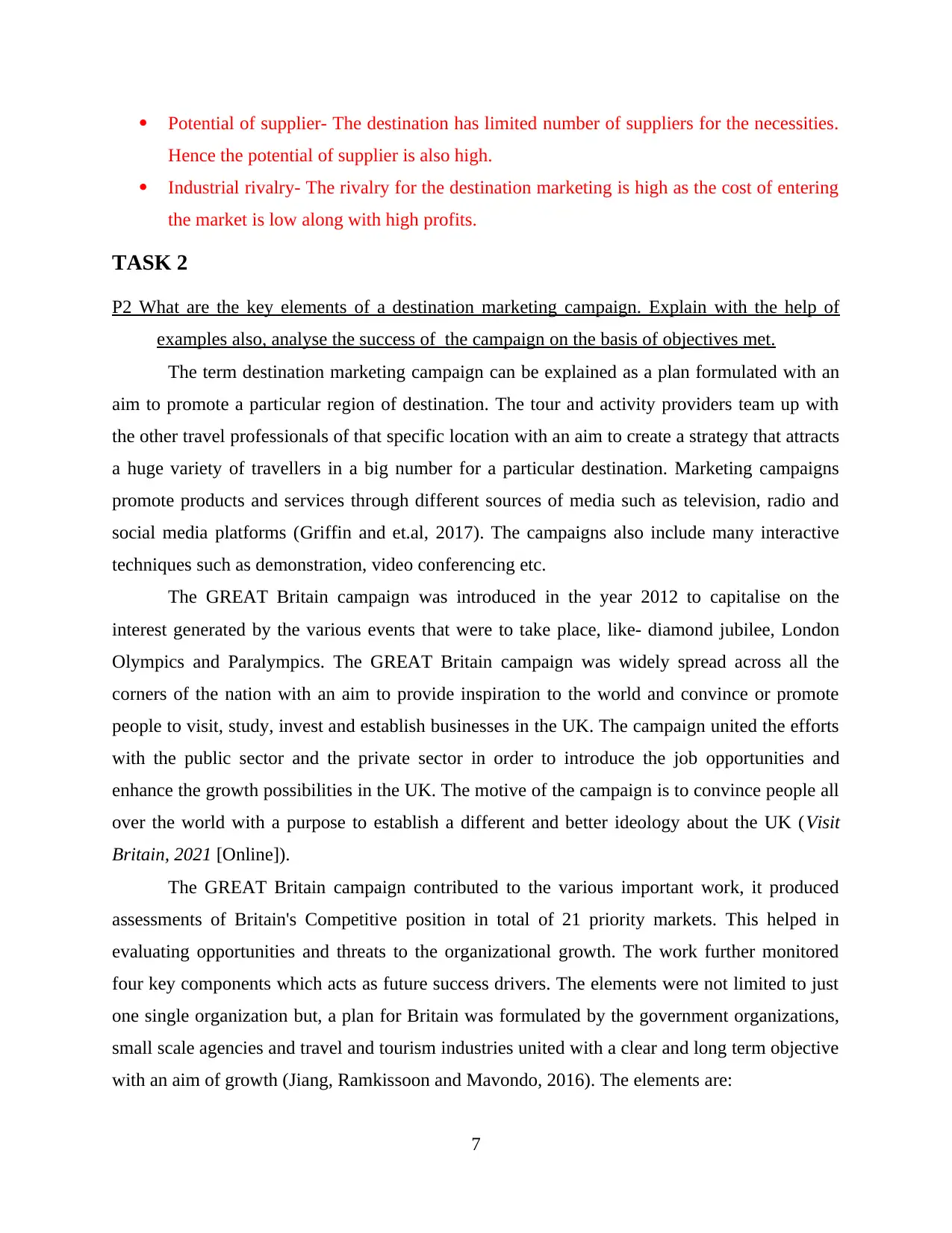
Potential of supplier- The destination has limited number of suppliers for the necessities.
Hence the potential of supplier is also high.
Industrial rivalry- The rivalry for the destination marketing is high as the cost of entering
the market is low along with high profits.
TASK 2
P2 What are the key elements of a destination marketing campaign. Explain with the help of
examples also, analyse the success of the campaign on the basis of objectives met.
The term destination marketing campaign can be explained as a plan formulated with an
aim to promote a particular region of destination. The tour and activity providers team up with
the other travel professionals of that specific location with an aim to create a strategy that attracts
a huge variety of travellers in a big number for a particular destination. Marketing campaigns
promote products and services through different sources of media such as television, radio and
social media platforms (Griffin and et.al, 2017). The campaigns also include many interactive
techniques such as demonstration, video conferencing etc.
The GREAT Britain campaign was introduced in the year 2012 to capitalise on the
interest generated by the various events that were to take place, like- diamond jubilee, London
Olympics and Paralympics. The GREAT Britain campaign was widely spread across all the
corners of the nation with an aim to provide inspiration to the world and convince or promote
people to visit, study, invest and establish businesses in the UK. The campaign united the efforts
with the public sector and the private sector in order to introduce the job opportunities and
enhance the growth possibilities in the UK. The motive of the campaign is to convince people all
over the world with a purpose to establish a different and better ideology about the UK (Visit
Britain, 2021 [Online]).
The GREAT Britain campaign contributed to the various important work, it produced
assessments of Britain's Competitive position in total of 21 priority markets. This helped in
evaluating opportunities and threats to the organizational growth. The work further monitored
four key components which acts as future success drivers. The elements were not limited to just
one single organization but, a plan for Britain was formulated by the government organizations,
small scale agencies and travel and tourism industries united with a clear and long term objective
with an aim of growth (Jiang, Ramkissoon and Mavondo, 2016). The elements are:
7
Hence the potential of supplier is also high.
Industrial rivalry- The rivalry for the destination marketing is high as the cost of entering
the market is low along with high profits.
TASK 2
P2 What are the key elements of a destination marketing campaign. Explain with the help of
examples also, analyse the success of the campaign on the basis of objectives met.
The term destination marketing campaign can be explained as a plan formulated with an
aim to promote a particular region of destination. The tour and activity providers team up with
the other travel professionals of that specific location with an aim to create a strategy that attracts
a huge variety of travellers in a big number for a particular destination. Marketing campaigns
promote products and services through different sources of media such as television, radio and
social media platforms (Griffin and et.al, 2017). The campaigns also include many interactive
techniques such as demonstration, video conferencing etc.
The GREAT Britain campaign was introduced in the year 2012 to capitalise on the
interest generated by the various events that were to take place, like- diamond jubilee, London
Olympics and Paralympics. The GREAT Britain campaign was widely spread across all the
corners of the nation with an aim to provide inspiration to the world and convince or promote
people to visit, study, invest and establish businesses in the UK. The campaign united the efforts
with the public sector and the private sector in order to introduce the job opportunities and
enhance the growth possibilities in the UK. The motive of the campaign is to convince people all
over the world with a purpose to establish a different and better ideology about the UK (Visit
Britain, 2021 [Online]).
The GREAT Britain campaign contributed to the various important work, it produced
assessments of Britain's Competitive position in total of 21 priority markets. This helped in
evaluating opportunities and threats to the organizational growth. The work further monitored
four key components which acts as future success drivers. The elements were not limited to just
one single organization but, a plan for Britain was formulated by the government organizations,
small scale agencies and travel and tourism industries united with a clear and long term objective
with an aim of growth (Jiang, Ramkissoon and Mavondo, 2016). The elements are:
7
Paraphrase This Document
Need a fresh take? Get an instant paraphrase of this document with our AI Paraphraser
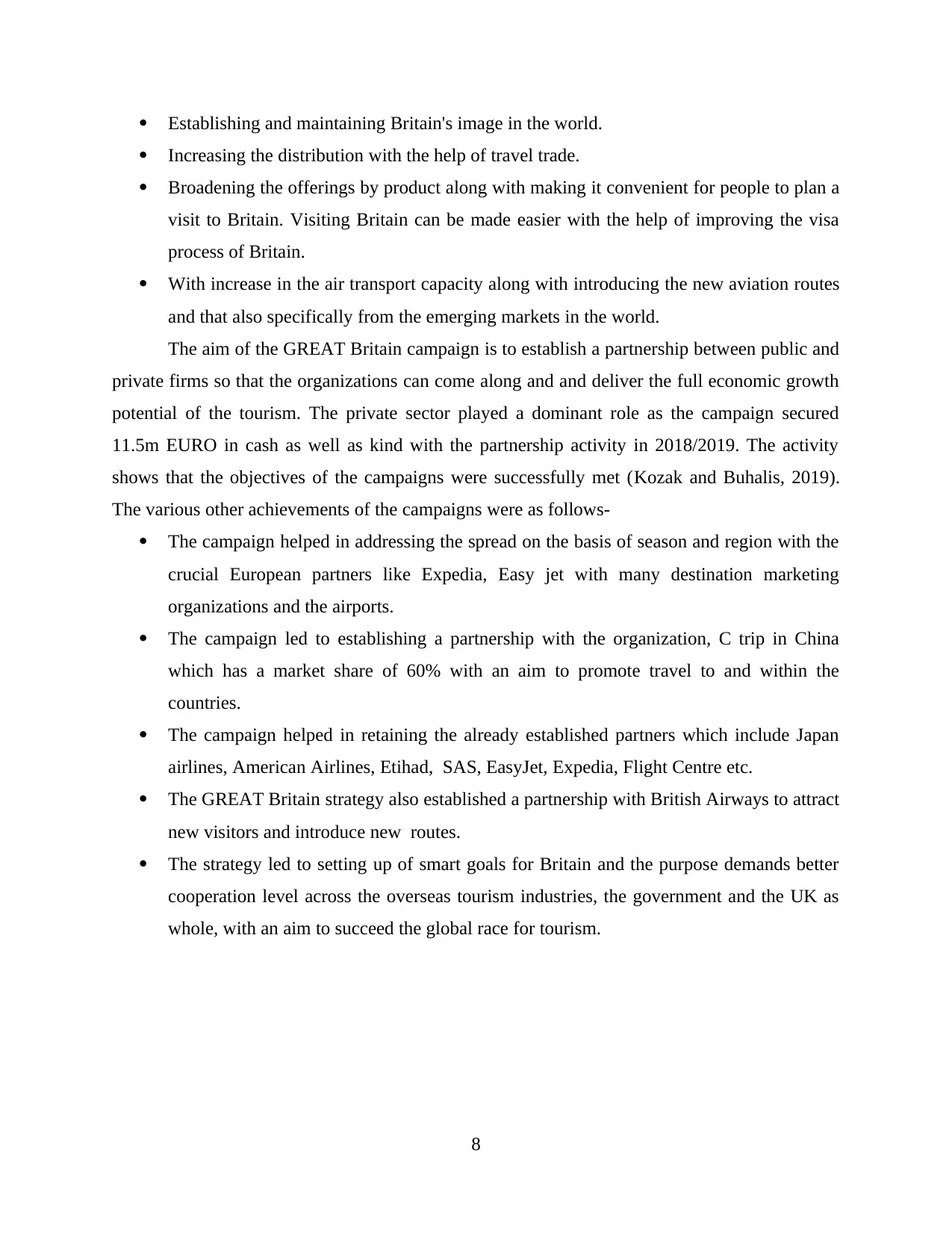
Establishing and maintaining Britain's image in the world.
Increasing the distribution with the help of travel trade.
Broadening the offerings by product along with making it convenient for people to plan a
visit to Britain. Visiting Britain can be made easier with the help of improving the visa
process of Britain.
With increase in the air transport capacity along with introducing the new aviation routes
and that also specifically from the emerging markets in the world.
The aim of the GREAT Britain campaign is to establish a partnership between public and
private firms so that the organizations can come along and and deliver the full economic growth
potential of the tourism. The private sector played a dominant role as the campaign secured
11.5m EURO in cash as well as kind with the partnership activity in 2018/2019. The activity
shows that the objectives of the campaigns were successfully met (Kozak and Buhalis, 2019).
The various other achievements of the campaigns were as follows-
The campaign helped in addressing the spread on the basis of season and region with the
crucial European partners like Expedia, Easy jet with many destination marketing
organizations and the airports.
The campaign led to establishing a partnership with the organization, C trip in China
which has a market share of 60% with an aim to promote travel to and within the
countries.
The campaign helped in retaining the already established partners which include Japan
airlines, American Airlines, Etihad, SAS, EasyJet, Expedia, Flight Centre etc.
The GREAT Britain strategy also established a partnership with British Airways to attract
new visitors and introduce new routes.
The strategy led to setting up of smart goals for Britain and the purpose demands better
cooperation level across the overseas tourism industries, the government and the UK as
whole, with an aim to succeed the global race for tourism.
8
Increasing the distribution with the help of travel trade.
Broadening the offerings by product along with making it convenient for people to plan a
visit to Britain. Visiting Britain can be made easier with the help of improving the visa
process of Britain.
With increase in the air transport capacity along with introducing the new aviation routes
and that also specifically from the emerging markets in the world.
The aim of the GREAT Britain campaign is to establish a partnership between public and
private firms so that the organizations can come along and and deliver the full economic growth
potential of the tourism. The private sector played a dominant role as the campaign secured
11.5m EURO in cash as well as kind with the partnership activity in 2018/2019. The activity
shows that the objectives of the campaigns were successfully met (Kozak and Buhalis, 2019).
The various other achievements of the campaigns were as follows-
The campaign helped in addressing the spread on the basis of season and region with the
crucial European partners like Expedia, Easy jet with many destination marketing
organizations and the airports.
The campaign led to establishing a partnership with the organization, C trip in China
which has a market share of 60% with an aim to promote travel to and within the
countries.
The campaign helped in retaining the already established partners which include Japan
airlines, American Airlines, Etihad, SAS, EasyJet, Expedia, Flight Centre etc.
The GREAT Britain strategy also established a partnership with British Airways to attract
new visitors and introduce new routes.
The strategy led to setting up of smart goals for Britain and the purpose demands better
cooperation level across the overseas tourism industries, the government and the UK as
whole, with an aim to succeed the global race for tourism.
8
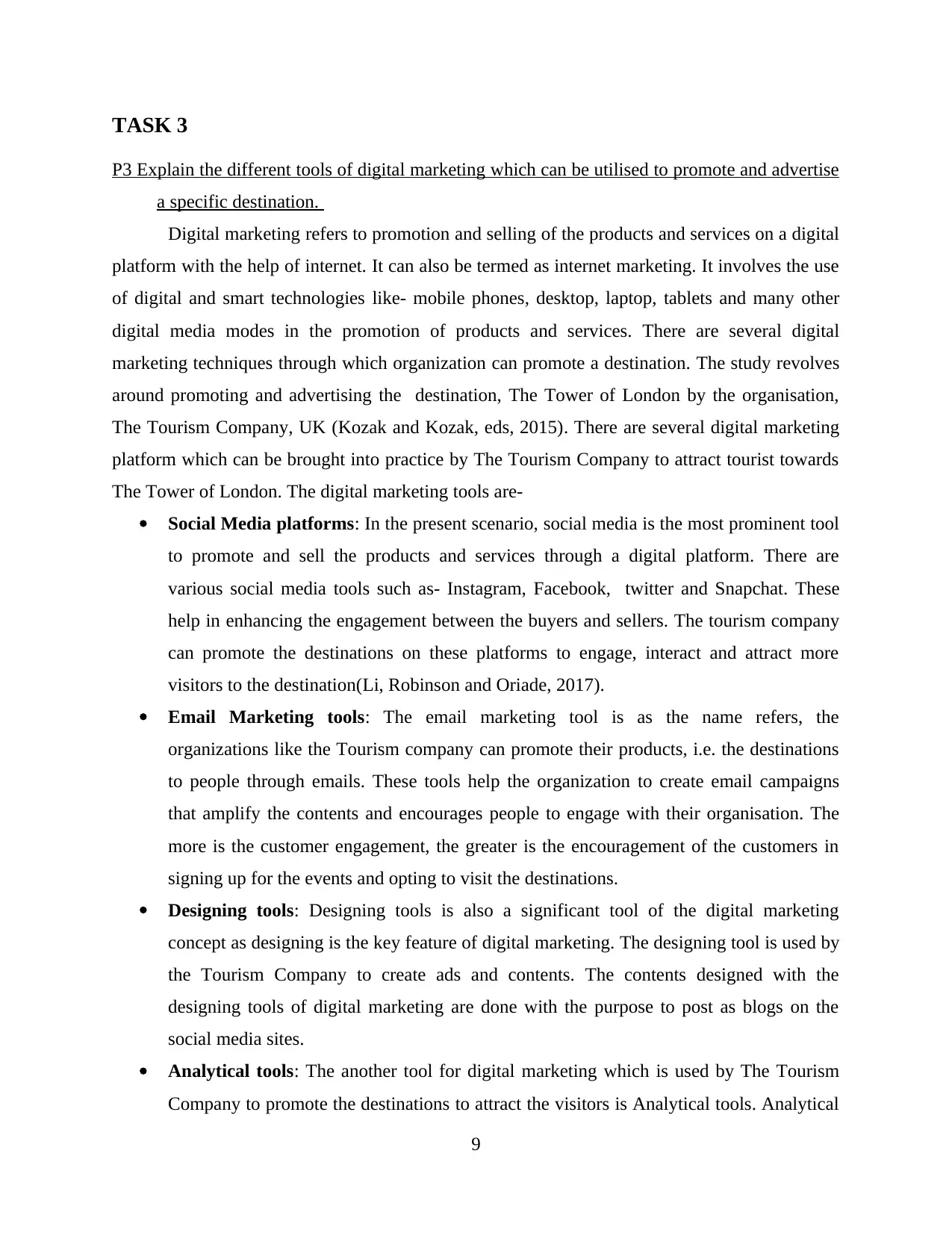
TASK 3
P3 Explain the different tools of digital marketing which can be utilised to promote and advertise
a specific destination.
Digital marketing refers to promotion and selling of the products and services on a digital
platform with the help of internet. It can also be termed as internet marketing. It involves the use
of digital and smart technologies like- mobile phones, desktop, laptop, tablets and many other
digital media modes in the promotion of products and services. There are several digital
marketing techniques through which organization can promote a destination. The study revolves
around promoting and advertising the destination, The Tower of London by the organisation,
The Tourism Company, UK (Kozak and Kozak, eds, 2015). There are several digital marketing
platform which can be brought into practice by The Tourism Company to attract tourist towards
The Tower of London. The digital marketing tools are-
Social Media platforms: In the present scenario, social media is the most prominent tool
to promote and sell the products and services through a digital platform. There are
various social media tools such as- Instagram, Facebook, twitter and Snapchat. These
help in enhancing the engagement between the buyers and sellers. The tourism company
can promote the destinations on these platforms to engage, interact and attract more
visitors to the destination(Li, Robinson and Oriade, 2017).
Email Marketing tools: The email marketing tool is as the name refers, the
organizations like the Tourism company can promote their products, i.e. the destinations
to people through emails. These tools help the organization to create email campaigns
that amplify the contents and encourages people to engage with their organisation. The
more is the customer engagement, the greater is the encouragement of the customers in
signing up for the events and opting to visit the destinations.
Designing tools: Designing tools is also a significant tool of the digital marketing
concept as designing is the key feature of digital marketing. The designing tool is used by
the Tourism Company to create ads and contents. The contents designed with the
designing tools of digital marketing are done with the purpose to post as blogs on the
social media sites.
Analytical tools: The another tool for digital marketing which is used by The Tourism
Company to promote the destinations to attract the visitors is Analytical tools. Analytical
9
P3 Explain the different tools of digital marketing which can be utilised to promote and advertise
a specific destination.
Digital marketing refers to promotion and selling of the products and services on a digital
platform with the help of internet. It can also be termed as internet marketing. It involves the use
of digital and smart technologies like- mobile phones, desktop, laptop, tablets and many other
digital media modes in the promotion of products and services. There are several digital
marketing techniques through which organization can promote a destination. The study revolves
around promoting and advertising the destination, The Tower of London by the organisation,
The Tourism Company, UK (Kozak and Kozak, eds, 2015). There are several digital marketing
platform which can be brought into practice by The Tourism Company to attract tourist towards
The Tower of London. The digital marketing tools are-
Social Media platforms: In the present scenario, social media is the most prominent tool
to promote and sell the products and services through a digital platform. There are
various social media tools such as- Instagram, Facebook, twitter and Snapchat. These
help in enhancing the engagement between the buyers and sellers. The tourism company
can promote the destinations on these platforms to engage, interact and attract more
visitors to the destination(Li, Robinson and Oriade, 2017).
Email Marketing tools: The email marketing tool is as the name refers, the
organizations like the Tourism company can promote their products, i.e. the destinations
to people through emails. These tools help the organization to create email campaigns
that amplify the contents and encourages people to engage with their organisation. The
more is the customer engagement, the greater is the encouragement of the customers in
signing up for the events and opting to visit the destinations.
Designing tools: Designing tools is also a significant tool of the digital marketing
concept as designing is the key feature of digital marketing. The designing tool is used by
the Tourism Company to create ads and contents. The contents designed with the
designing tools of digital marketing are done with the purpose to post as blogs on the
social media sites.
Analytical tools: The another tool for digital marketing which is used by The Tourism
Company to promote the destinations to attract the visitors is Analytical tools. Analytical
9
⊘ This is a preview!⊘
Do you want full access?
Subscribe today to unlock all pages.

Trusted by 1+ million students worldwide
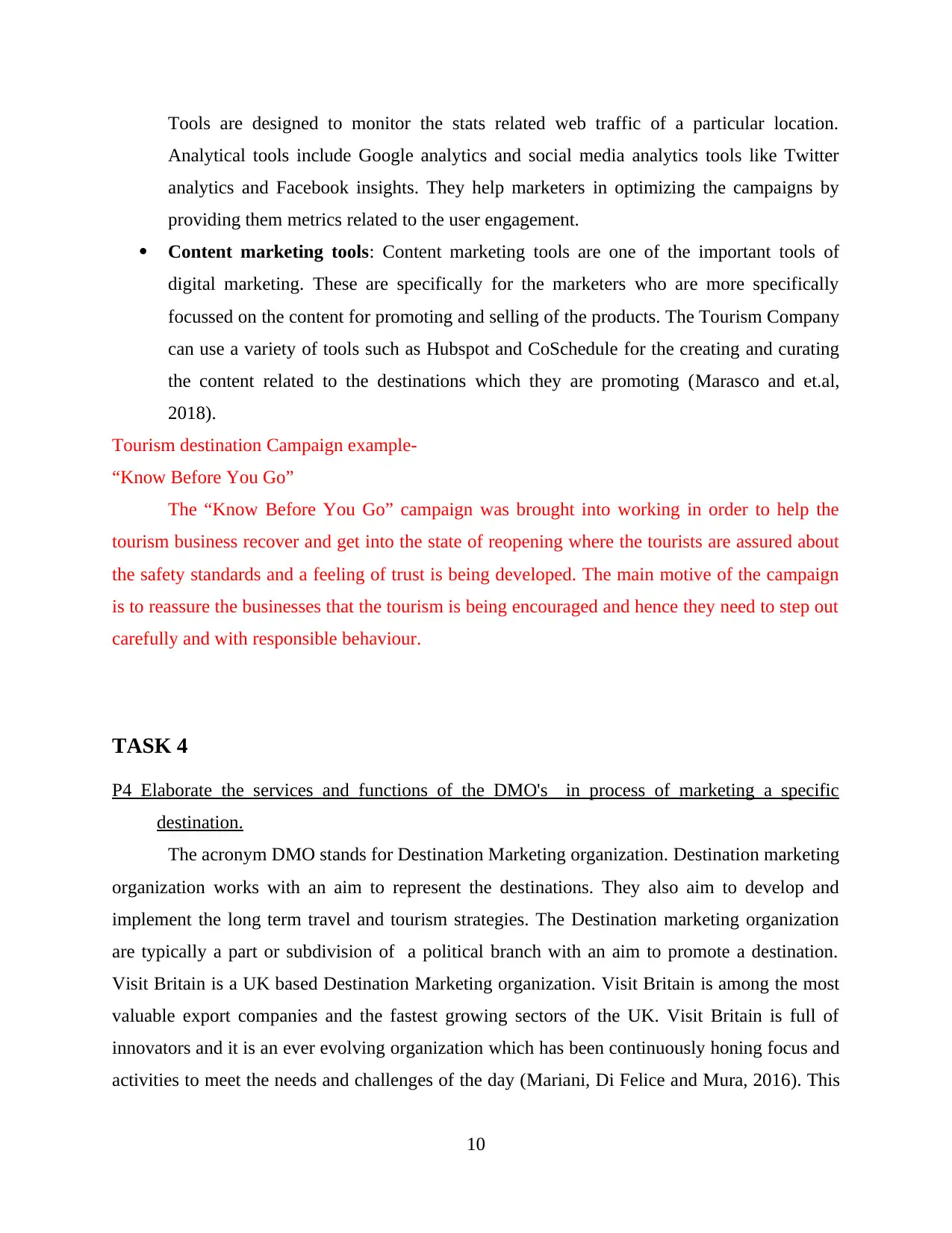
Tools are designed to monitor the stats related web traffic of a particular location.
Analytical tools include Google analytics and social media analytics tools like Twitter
analytics and Facebook insights. They help marketers in optimizing the campaigns by
providing them metrics related to the user engagement.
Content marketing tools: Content marketing tools are one of the important tools of
digital marketing. These are specifically for the marketers who are more specifically
focussed on the content for promoting and selling of the products. The Tourism Company
can use a variety of tools such as Hubspot and CoSchedule for the creating and curating
the content related to the destinations which they are promoting (Marasco and et.al,
2018).
Tourism destination Campaign example-
“Know Before You Go”
The “Know Before You Go” campaign was brought into working in order to help the
tourism business recover and get into the state of reopening where the tourists are assured about
the safety standards and a feeling of trust is being developed. The main motive of the campaign
is to reassure the businesses that the tourism is being encouraged and hence they need to step out
carefully and with responsible behaviour.
TASK 4
P4 Elaborate the services and functions of the DMO's in process of marketing a specific
destination.
The acronym DMO stands for Destination Marketing organization. Destination marketing
organization works with an aim to represent the destinations. They also aim to develop and
implement the long term travel and tourism strategies. The Destination marketing organization
are typically a part or subdivision of a political branch with an aim to promote a destination.
Visit Britain is a UK based Destination Marketing organization. Visit Britain is among the most
valuable export companies and the fastest growing sectors of the UK. Visit Britain is full of
innovators and it is an ever evolving organization which has been continuously honing focus and
activities to meet the needs and challenges of the day (Mariani, Di Felice and Mura, 2016). This
10
Analytical tools include Google analytics and social media analytics tools like Twitter
analytics and Facebook insights. They help marketers in optimizing the campaigns by
providing them metrics related to the user engagement.
Content marketing tools: Content marketing tools are one of the important tools of
digital marketing. These are specifically for the marketers who are more specifically
focussed on the content for promoting and selling of the products. The Tourism Company
can use a variety of tools such as Hubspot and CoSchedule for the creating and curating
the content related to the destinations which they are promoting (Marasco and et.al,
2018).
Tourism destination Campaign example-
“Know Before You Go”
The “Know Before You Go” campaign was brought into working in order to help the
tourism business recover and get into the state of reopening where the tourists are assured about
the safety standards and a feeling of trust is being developed. The main motive of the campaign
is to reassure the businesses that the tourism is being encouraged and hence they need to step out
carefully and with responsible behaviour.
TASK 4
P4 Elaborate the services and functions of the DMO's in process of marketing a specific
destination.
The acronym DMO stands for Destination Marketing organization. Destination marketing
organization works with an aim to represent the destinations. They also aim to develop and
implement the long term travel and tourism strategies. The Destination marketing organization
are typically a part or subdivision of a political branch with an aim to promote a destination.
Visit Britain is a UK based Destination Marketing organization. Visit Britain is among the most
valuable export companies and the fastest growing sectors of the UK. Visit Britain is full of
innovators and it is an ever evolving organization which has been continuously honing focus and
activities to meet the needs and challenges of the day (Mariani, Di Felice and Mura, 2016). This
10
Paraphrase This Document
Need a fresh take? Get an instant paraphrase of this document with our AI Paraphraser
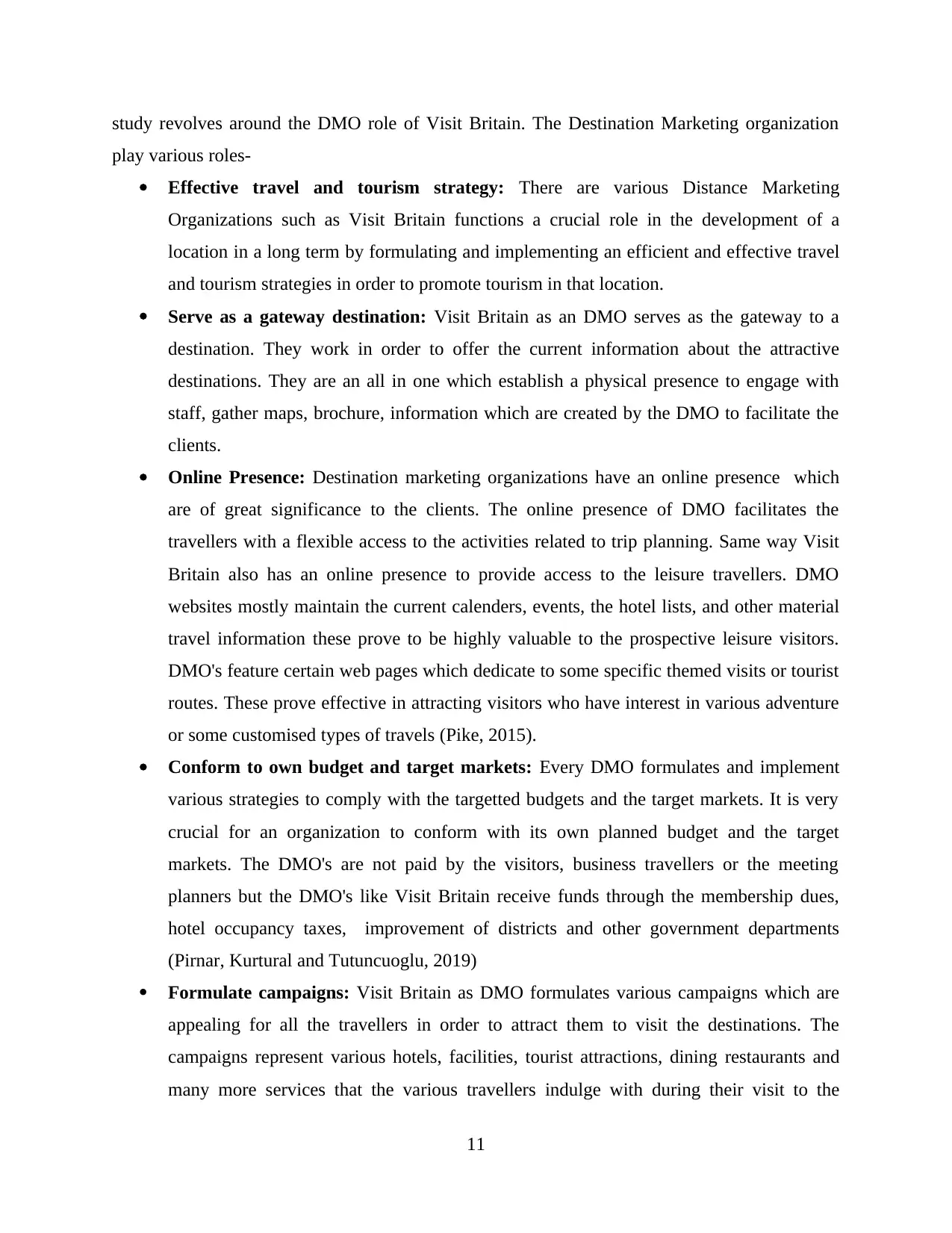
study revolves around the DMO role of Visit Britain. The Destination Marketing organization
play various roles-
Effective travel and tourism strategy: There are various Distance Marketing
Organizations such as Visit Britain functions a crucial role in the development of a
location in a long term by formulating and implementing an efficient and effective travel
and tourism strategies in order to promote tourism in that location.
Serve as a gateway destination: Visit Britain as an DMO serves as the gateway to a
destination. They work in order to offer the current information about the attractive
destinations. They are an all in one which establish a physical presence to engage with
staff, gather maps, brochure, information which are created by the DMO to facilitate the
clients.
Online Presence: Destination marketing organizations have an online presence which
are of great significance to the clients. The online presence of DMO facilitates the
travellers with a flexible access to the activities related to trip planning. Same way Visit
Britain also has an online presence to provide access to the leisure travellers. DMO
websites mostly maintain the current calenders, events, the hotel lists, and other material
travel information these prove to be highly valuable to the prospective leisure visitors.
DMO's feature certain web pages which dedicate to some specific themed visits or tourist
routes. These prove effective in attracting visitors who have interest in various adventure
or some customised types of travels (Pike, 2015).
Conform to own budget and target markets: Every DMO formulates and implement
various strategies to comply with the targetted budgets and the target markets. It is very
crucial for an organization to conform with its own planned budget and the target
markets. The DMO's are not paid by the visitors, business travellers or the meeting
planners but the DMO's like Visit Britain receive funds through the membership dues,
hotel occupancy taxes, improvement of districts and other government departments
(Pirnar, Kurtural and Tutuncuoglu, 2019)
Formulate campaigns: Visit Britain as DMO formulates various campaigns which are
appealing for all the travellers in order to attract them to visit the destinations. The
campaigns represent various hotels, facilities, tourist attractions, dining restaurants and
many more services that the various travellers indulge with during their visit to the
11
play various roles-
Effective travel and tourism strategy: There are various Distance Marketing
Organizations such as Visit Britain functions a crucial role in the development of a
location in a long term by formulating and implementing an efficient and effective travel
and tourism strategies in order to promote tourism in that location.
Serve as a gateway destination: Visit Britain as an DMO serves as the gateway to a
destination. They work in order to offer the current information about the attractive
destinations. They are an all in one which establish a physical presence to engage with
staff, gather maps, brochure, information which are created by the DMO to facilitate the
clients.
Online Presence: Destination marketing organizations have an online presence which
are of great significance to the clients. The online presence of DMO facilitates the
travellers with a flexible access to the activities related to trip planning. Same way Visit
Britain also has an online presence to provide access to the leisure travellers. DMO
websites mostly maintain the current calenders, events, the hotel lists, and other material
travel information these prove to be highly valuable to the prospective leisure visitors.
DMO's feature certain web pages which dedicate to some specific themed visits or tourist
routes. These prove effective in attracting visitors who have interest in various adventure
or some customised types of travels (Pike, 2015).
Conform to own budget and target markets: Every DMO formulates and implement
various strategies to comply with the targetted budgets and the target markets. It is very
crucial for an organization to conform with its own planned budget and the target
markets. The DMO's are not paid by the visitors, business travellers or the meeting
planners but the DMO's like Visit Britain receive funds through the membership dues,
hotel occupancy taxes, improvement of districts and other government departments
(Pirnar, Kurtural and Tutuncuoglu, 2019)
Formulate campaigns: Visit Britain as DMO formulates various campaigns which are
appealing for all the travellers in order to attract them to visit the destinations. The
campaigns represent various hotels, facilities, tourist attractions, dining restaurants and
many more services that the various travellers indulge with during their visit to the
11
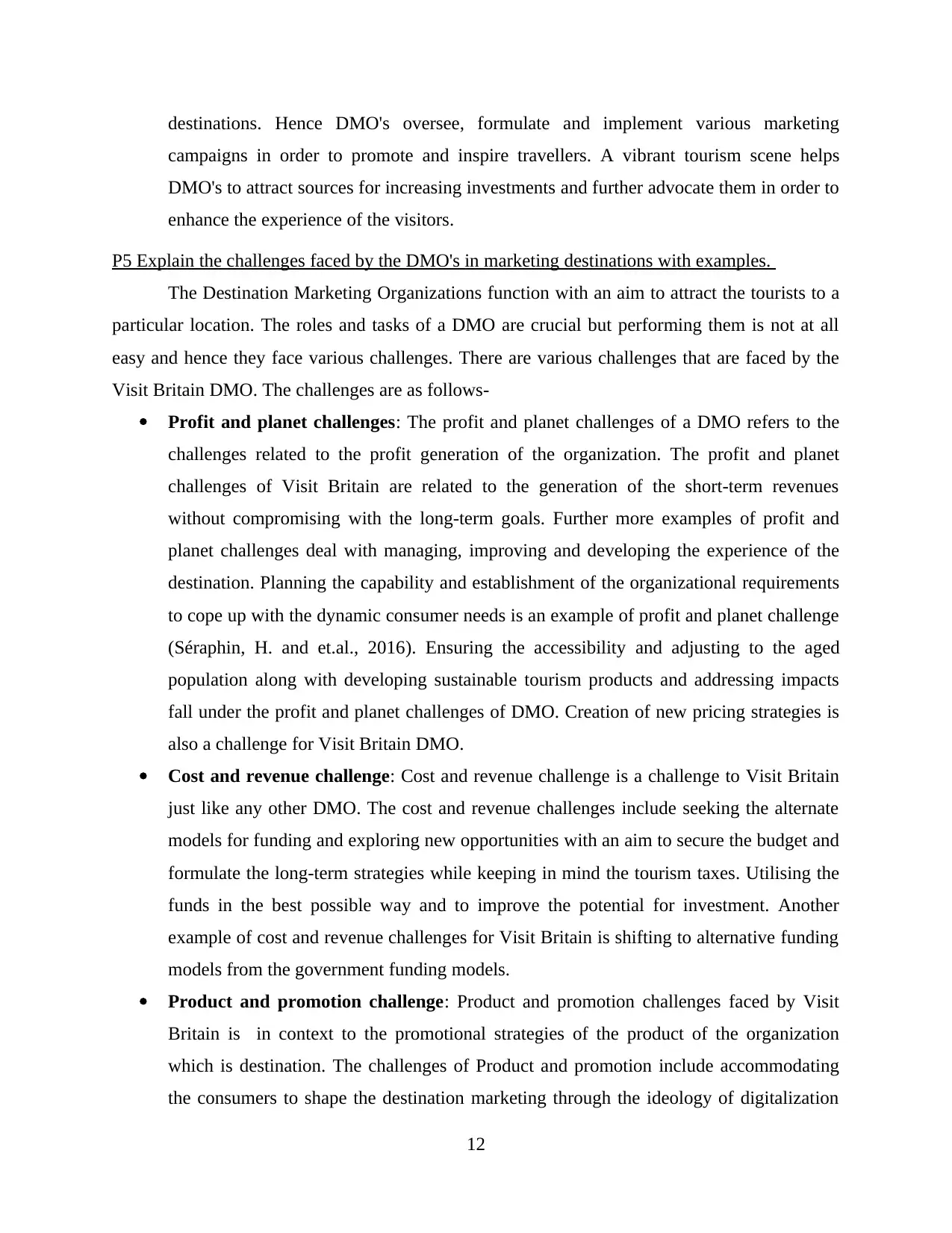
destinations. Hence DMO's oversee, formulate and implement various marketing
campaigns in order to promote and inspire travellers. A vibrant tourism scene helps
DMO's to attract sources for increasing investments and further advocate them in order to
enhance the experience of the visitors.
P5 Explain the challenges faced by the DMO's in marketing destinations with examples.
The Destination Marketing Organizations function with an aim to attract the tourists to a
particular location. The roles and tasks of a DMO are crucial but performing them is not at all
easy and hence they face various challenges. There are various challenges that are faced by the
Visit Britain DMO. The challenges are as follows-
Profit and planet challenges: The profit and planet challenges of a DMO refers to the
challenges related to the profit generation of the organization. The profit and planet
challenges of Visit Britain are related to the generation of the short-term revenues
without compromising with the long-term goals. Further more examples of profit and
planet challenges deal with managing, improving and developing the experience of the
destination. Planning the capability and establishment of the organizational requirements
to cope up with the dynamic consumer needs is an example of profit and planet challenge
(Séraphin, H. and et.al., 2016). Ensuring the accessibility and adjusting to the aged
population along with developing sustainable tourism products and addressing impacts
fall under the profit and planet challenges of DMO. Creation of new pricing strategies is
also a challenge for Visit Britain DMO.
Cost and revenue challenge: Cost and revenue challenge is a challenge to Visit Britain
just like any other DMO. The cost and revenue challenges include seeking the alternate
models for funding and exploring new opportunities with an aim to secure the budget and
formulate the long-term strategies while keeping in mind the tourism taxes. Utilising the
funds in the best possible way and to improve the potential for investment. Another
example of cost and revenue challenges for Visit Britain is shifting to alternative funding
models from the government funding models.
Product and promotion challenge: Product and promotion challenges faced by Visit
Britain is in context to the promotional strategies of the product of the organization
which is destination. The challenges of Product and promotion include accommodating
the consumers to shape the destination marketing through the ideology of digitalization
12
campaigns in order to promote and inspire travellers. A vibrant tourism scene helps
DMO's to attract sources for increasing investments and further advocate them in order to
enhance the experience of the visitors.
P5 Explain the challenges faced by the DMO's in marketing destinations with examples.
The Destination Marketing Organizations function with an aim to attract the tourists to a
particular location. The roles and tasks of a DMO are crucial but performing them is not at all
easy and hence they face various challenges. There are various challenges that are faced by the
Visit Britain DMO. The challenges are as follows-
Profit and planet challenges: The profit and planet challenges of a DMO refers to the
challenges related to the profit generation of the organization. The profit and planet
challenges of Visit Britain are related to the generation of the short-term revenues
without compromising with the long-term goals. Further more examples of profit and
planet challenges deal with managing, improving and developing the experience of the
destination. Planning the capability and establishment of the organizational requirements
to cope up with the dynamic consumer needs is an example of profit and planet challenge
(Séraphin, H. and et.al., 2016). Ensuring the accessibility and adjusting to the aged
population along with developing sustainable tourism products and addressing impacts
fall under the profit and planet challenges of DMO. Creation of new pricing strategies is
also a challenge for Visit Britain DMO.
Cost and revenue challenge: Cost and revenue challenge is a challenge to Visit Britain
just like any other DMO. The cost and revenue challenges include seeking the alternate
models for funding and exploring new opportunities with an aim to secure the budget and
formulate the long-term strategies while keeping in mind the tourism taxes. Utilising the
funds in the best possible way and to improve the potential for investment. Another
example of cost and revenue challenges for Visit Britain is shifting to alternative funding
models from the government funding models.
Product and promotion challenge: Product and promotion challenges faced by Visit
Britain is in context to the promotional strategies of the product of the organization
which is destination. The challenges of Product and promotion include accommodating
the consumers to shape the destination marketing through the ideology of digitalization
12
⊘ This is a preview!⊘
Do you want full access?
Subscribe today to unlock all pages.

Trusted by 1+ million students worldwide
1 out of 15
Related Documents
Your All-in-One AI-Powered Toolkit for Academic Success.
+13062052269
info@desklib.com
Available 24*7 on WhatsApp / Email
![[object Object]](/_next/static/media/star-bottom.7253800d.svg)
Unlock your academic potential
Copyright © 2020–2025 A2Z Services. All Rights Reserved. Developed and managed by ZUCOL.





